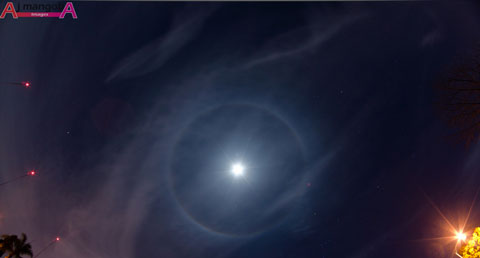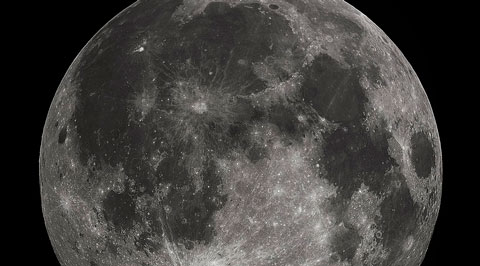India's Connection to the Stars
Over the past few centuries, astronomers have deeply enhanced our understanding of the night sky thanks to sophisticated new technologies and approaches.
Despite our growing scientific knowledge, many people’s day-to-day (or night-to-night) relationship with the stars has become increasingly distant. Light pollution in major cities obscures many of the beautiful stars and structures that illuminate the sky. In the past, however, the stars and other celestial bodies had a huge impact on religion, travel, and agriculture.
Changes in the appearance of the moon’s halo, for instance, indicates the presence of ice crystals in high clouds that might be a harbinger for future rainstorms. Clouds that obscure only the most distant constellations may also indicate imminent stormy weather. And some stars have played critical roles for navigation across the sea.

An example of the Moon's halo, which can be a rudimentary tool for predicting weather changes. Changes in cloud formation affect the appearance of the halo from our perspective on the ground.
Image Credit: AJ Mangoba via Flickr | Rights Information
Archaeoastronomers study these relationships that past civilizations have had with the night sky, and ethnoastronomers study the same relationship in present-day populations.
Recently, a group of ethnoastronomers based in India set out to better understand the astronomy of major ethnic groups in that country and published their results online. Despite the various ethnic groups’ geographic proximity, the researchers found that the groups’ astronomical beliefs differed in several important ways.
For their research, astrophysicist Mayank N. Vahia and his team traveled to various villages across India to conduct interviews about the astronomy of two ethnic groups in particular: the Banjaras and the Kolams.
The Banjaras
The Banjaras are one of the larger ethnic groups in India, with their nearly 5,000,000-person population residing across India but largely in the Southern and Eastern parts of the country. While the Banjaras have been nomadic for much of their history, they’ve become more settled over the past few years. Many of the Banjaras people assimilate to a degree with India’s modern urban areas, but they still largely maintain their historical cultural traditions and practices in day-to-day life, according to Vahia and his team.
The researchers’ interviews at seven different villages revealed that the Banjaras had the least sophisticated astronomy among the ethnic groups they have studied, and the Banjaras astronomy had few distinguishing characteristics. For instance, the Banjaras people have not typically used the stars for navigation, despite their nomadic history.
Nonetheless, the Banjaras do have a few unique astronomical interpretations. For example, the lunar maria — large, dark areas on the moon resulting from ancient volcanic eruptions — represent an old woman weaving cotton under a banyan tree.

The dark spots on the moon (lunar maria) hold special significance in Banjaras astronomy.
Image Credit: Gregory H. Revera via Wikimedia Commons | Rights Information
All of the Banjaras villages recognized the Orion constellation and the Big Dipper and incorporated them into their religious traditions. But only a few villages used the moon and the stars to predict the weather. For instance, some villages used the glow surrounding the moon (due to variations in cloud activity) to predict monsoons, but several others did not.
The Kolams
The Kolams are a much smaller tribal group (roughly 400,000 population), but they have a more extensive and distinct astronomical belief system than the Banjaras.
In total, the researchers visited 10 Kolam villages and found slightly more uniform beliefs than among the Banjaras. For instance, nearly all villages attached great significance to solar eclipses, the Great Square of Pegasus, Orion, the Pleiades, and the Big Dipper.
Partial solar eclipses represent a partial payment by the sun to the Kolam people, and the rest of the tab has to be picked up by either humans or animals per Kolam culture.

A solar eclipse seen over Chaos Crags in California.
Image Credit: Eric Leslie via flickr | Rights Information
For lunar eclipses, the Kolam people believe a “caterpillar or scorpion is eating the Moon,” if it’s light red and the moon is “dark red if a frog is eating it,” according to the researchers' paper. The slight variations in the moon’s color during an eclipse actually result from changes in the composition of dust in the Earth’s atmosphere; more dust scatters more of the light passing through the atmosphere that eventually hits the lunar surface. These interpretations of both lunar and solar eclipses were unique to the Kolams.
The researchers noted that these distinctions between the different groups’ relationship with the sky mirrored their way of life. For instance, the Kolams were primarily foragers until modern times, and their beliefs toward various constellations were more “nebulous,” according to the researchers.
In contrast, the Gonds — a more agrarian ethnic group that the researchers studied in their previous work — have more astronomical knowledge and beliefs connected with the weather. As the researchers conclude, “…the relationship of man to the sky is a reflection of his relationship to the land.”
There’s plenty more information available in the researchers’ paper, which is available for free on the arXiv preprint server. They list their paper as being published in the most recent edition of the Journal of Astronomical History and Heritage.
-Brian Jacobsmeyer














